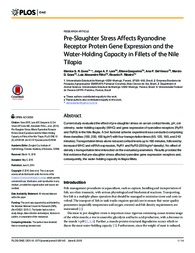Pre-Slaughter stress affects ryanodine receptor protein gene expression and the water-holding capacity in fillets of the nile Tilapia.
Pre-Slaughter stress affects ryanodine receptor protein gene expression and the water-holding capacity in fillets of the nile Tilapia.
Author(s): GOES, E. S. R.; LARA, J. A. F. de; GASPARINO, E.; DEL VESCO, A. P.; GOES, M. D.; ALEXANDRE FILHO, L.; RIBEIRO, R. P.
Summary: Current study evaluated the effect of pre-slaughter stress on serum cortisol levels, pH, colorimetry, water-holding capacity (WHC) and gene expression of ryanodine receptors (RyR1 and RyR3) in the Nile tilapia. A 3x4 factorial scheme experiment was conducted comprising three densities (100, 200, 400 kg/m³) with four transportation times (60, 120, 180, and 240 minutes).Transportation times alone reduced cortisol levels up to 180 minutes, followed by increased WHC and mRNA expression, RyR1 and RyR3 (200 kg/m³ density). No effect of density x transportation time interacted on the evaluated parameters. Results provided the first evidence that pre-slaughter stress affected ryanodine gene expression receptors and, consequently, the water-holding capacity in tilapia fillets.
Publication year: 2015
Types of publication: Journal article
Unit: Embrapa Pantanal
Observation
Some of Embrapa's publications are published as ePub files. To read them, use or download one of the following free software options to your computer or mobile device. Android: Google Play Books; IOS: iBooks; Windows and Linux: Calibre.
Access other publications
Access the Agricultural Research Database (BDPA) to consult Embrapa's full library collection and records.
Visit Embrapa Bookstore to purchase books and other publications sold by Embrapa.

